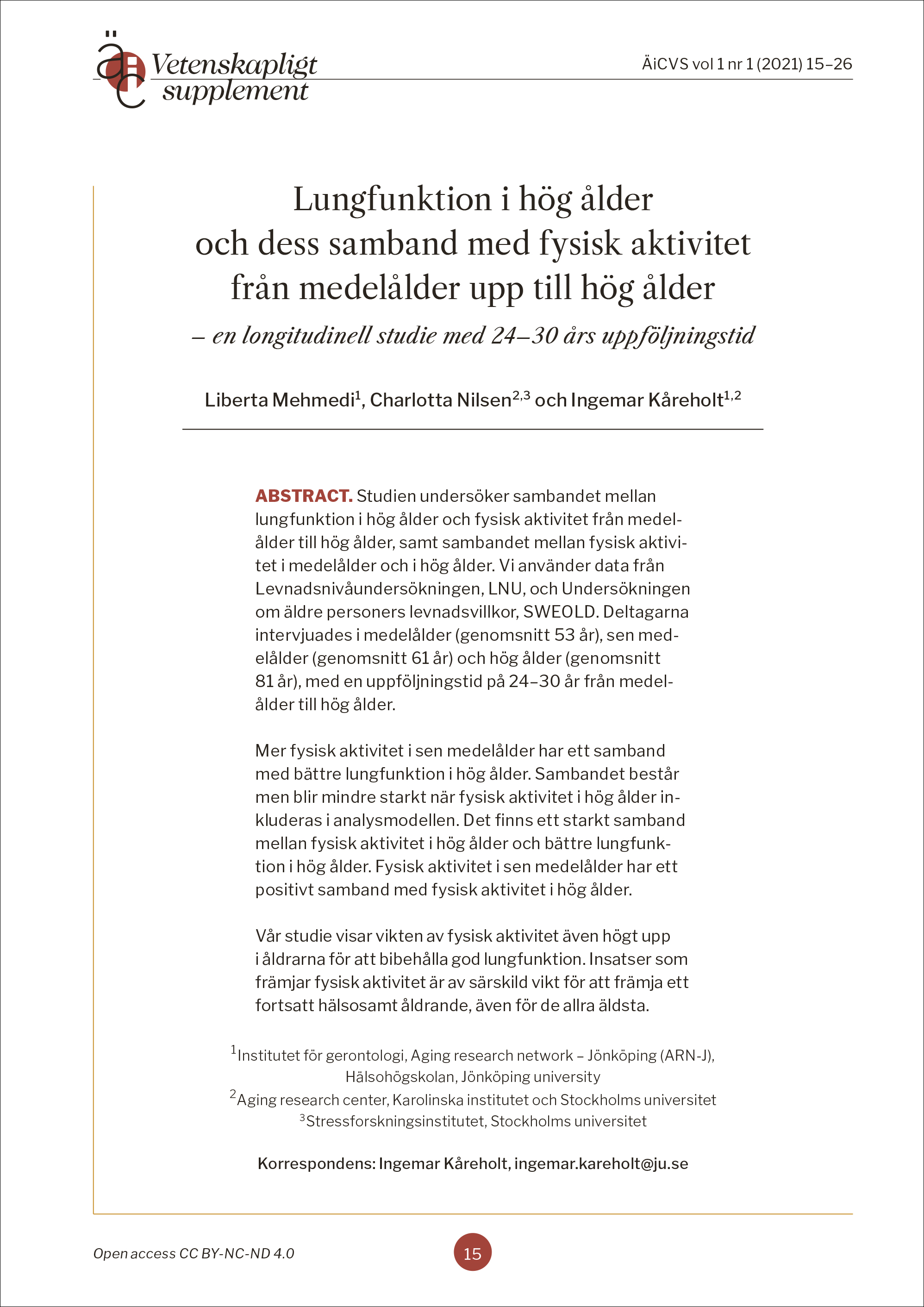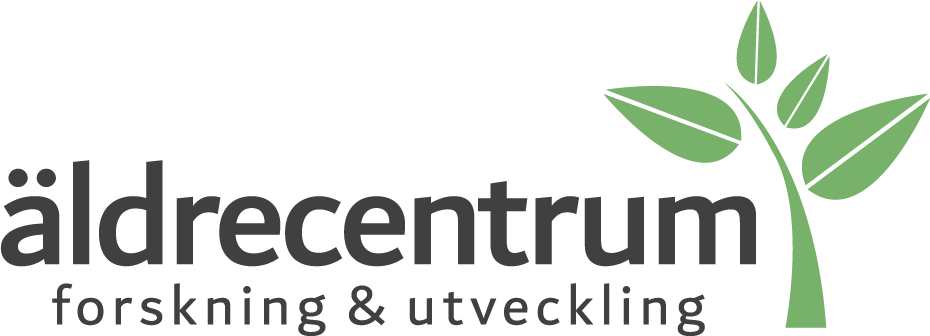Lungfunktion i hög ålder och dess samband med fysisk aktivitet från medelålder upp till hög ålder
En longitudinell studie med 24–30 års uppföljningstid
DOI:
https://doi.org/10.52585/icvs.v1i1.3Abstract
Studien undersöker sambandet mellan lungfunktion i hög ålder och fysisk aktivitet från medelålder till hög ålder, samt sambandet mellan fysisk aktivitet i medelålder och i hög ålder. Vi använder data från Levnadsnivåundersökningen, LNU, och Undersökningen om äldre personers levnadsvillkor, SWEOLD. Deltagarna intervjuades i medelålder (genomsnitt 53 år), sen medelålder (genomsnitt 61 år) och hög ålder (genomsnitt 81 år), med en uppföljningstid på 24–30 år från medelålder till hög ålder.
Mer fysisk aktivitet i sen medelålder har ett samband med bättre lungfunktion i hög ålder. Sambandet består men blir mindre starkt när fysisk aktivitet i hög ålder inkluderas i analysmodellen. Det finns ett starkt samband mellan fysisk aktivitet i hög ålder och bättre lungfunktion i hög ålder. Fysisk aktivitet i sen medelålder har ett positivt samband med fysisk aktivitet i hög ålder.
Vår studie visar vikten av fysisk aktivitet även högt upp i åldrarna för att bibehålla god lungfunktion. Insatser som främjar fysisk aktivitet är av särskild vikt för att främja ett fortsatt hälsosamt åldrande, även för de allra äldsta.
Lung function in older age and physical activity from midlife to older age – A longitudinal study with 24-30 years of follow-up
The study investigated the role of physical activity, from midlife to older age, in lung function in older age. In order to increase the understanding of the relationship between physical activity and lung function, the relationship between physical activity in midlife and physical activity in older age was also studied.
Two Swedish studies based on nationally representative samples were used in this study, the Level of living survey, LNU, and the Swedish panel study of living conditions of the oldest old, SWEOLD. The participants were interviewed on three occasions; at the mean ages of 53 years, 61 years, and 81 years. The average follow-up time from the last to the first interview was 24-30 years. The results show that more physical activity in late midlife (mean age of 61 years) was associated with better lung function in older age. The association persists but attenuates when physical activity in older age was included in the analyses. There was also a strong association between physical activity in older age and better lung function in older age. Physical activity in late midlife had a positive association with physical activity in older age. This study shows the importance of physical activity in late midlife and in older ages to maintain good lung function in older ages. To invest in preventive actions in the form of physical activity are vital to be able to promote healthy aging, and should include the oldest old (76+).
Referenser
Agahi N, Ahacic K, Perker MG. Continuity of leisure participation from middle age to old age. The Journals of gerontology: Series B. 2006;61(6):340-46. https://doi.org/10.1093/geronb/61.6.S340
Agahi N, Silverstein M, Parker MG. Late-life and earlier participation in leisure activities: their importance for survival among older persons. Activities, adaption and aging. 2011;35(3):210-22. https://doi.org/10.1080/01924788.2011.596758
Angrist JD, Pischke J-S. Mostly harmless econometrics: An empiricist's companion. Princeton university press; 2018:392.
Brandenberger C, Muhlfeld C. Mechanisms of lung aging. Cell and tissue research. 2016;367(3):469-80. https://doi.org/10.1007/s00441-016-2511-x
Dehlin O, Rundgren Å. Geriatrik. Studentlitteratur; 2014.
Elsawy B, Higgins KE. Physical activity guidelines for older adults. American family physician. 2010;81(1):55-62.
Ernsth Bravell M. Biologiskt åldrande. I: Ernsth Bravell M (red). Äldre och åldrande. Grundbok i Gerontologi. Gleerups utbildning; 2013: 93-118.
Finkel D, Sternäng O, Wahlin Å. Genetic and environmental influences on longitudinal trajectories of functional biological age: Comparisons across gender. Behavior genetics. 2017;47(4):375-82. https://doi.org/10.1007/s10519-017-9851-5
Fors S, Thorslund M. Enduring inequality: educational disparities in health among the oldest old in Sweden 1992-2011. International journal of public health. 2015;60(1);91-8. https://doi.org/10.1007/s00038-014-0621-3
Fritzell J, Lennartsson C, Lundberg O (red). Health inequalities and welfare resources – finding and forecasts. I: Fritzell J, Lundberg O. Health inequalities and welfare resources: Continuity and change in Sweden. Bristol university press; 2007. https://doi.org/10.2307/j.ctt9qgn85.16
Fuertes E, Carsin A-E, Anto JM, Bono R, Guido C, Demoly P m fl. Leisure-time vigorous physical activity is associated with better lung function: the prospective ECRHS study. Thorax. 2018;73(4):376-84. https://doi.org/10.1136/thoraxjnl-2017-210947
Gidlow C, Johnston LH, Crone, D. A systematic review of the relationship between socio-economic position and physical activity. Health education journal. 2006;65(4):338-67. https://doi.org/10.1177/0017896906069378
Havighurst RJ, Albrecht R. Older people. Longmans, Green; 1953.
Karasek RA. Job demands, job decision latitude, and mental strain: Implications for job redesign. Administrative science quarterly. 1979;24(2):285-308. https://doi.org/10.2307/2392498
Kelfve S. Underestimated health inequalities among older people – A consequence of excluding the most disabled and disadvantaged. The journals of gerontology: Series B. 2017;74(8):125-34. https://doi.org/10.1093/geronb/gbx032
Kelfve S, Thorslund M, Lennartsson C. Sampling and non-response bias on health-outcomes in surveys of the oldest old. European journal of ageing. 2013;10(3):237-45. https://doi.org/10.1007/s10433-013-0275-7
Leavy B, Åberg AC. "Not ready to throw in the towel": Perceptions of physical activity held by older adults in Stockholm and Dublin. Journal of aging and physical activity. 2010;18(2):219-36. https://doi.org/10.1123/japa.18.2.219
Lemon BW, Bengtson VL, Peterson JA. An exploration of the activity theory of aging: activity types and life satisfaction among in-movers to a retirement community. Journal of gerontology. 1972;27(4):511-23. https://doi.org/10.1093/geronj/27.4.511
Lennartsson C, Agahi N, Hols-Salén L, Kelfve S, Kåreholt I, Lundberg O m fl. Data resource profile: The Swedish panel study of living conditions of the oldest old (SWEOLD). International journal of epidemiology. 2014;43(3):731-38. https://doi.org/10.1093/ije/dyu057
Lundberg O, Thorslund M. Fieldwork and measurement considerations in surveys of the oldest old. Social indicators research. 1996;37(2):165-87. https://doi.org/10.1007/BF00315527
Martin-Ruiz C, Von Zglinicki T. A life course approach to biomarkers of ageing. I: Kuh D, Cooper R, Hardy R, Richards M, Ben-Shlomo Y (red). A life course approach to healthy ageing. Oxford university press; 2014: 177-83. https://doi.org/10.1093/acprof:oso/9780199656516.003.0013
Middleton LE, Kirkland SA, Rockwood K. Proxy reports of physical activity were valid in older people with and without cognitive impairment. Journal of clinical epidemiology. 2009;63(4):435-40. https://doi.org/10.1016/j.jclinepi.2009.06.009
Miranda APB, Gastaldi AC, Souza HCD, Santos JLF. The influence of physical fitness on respiratory muscle strength in the elderly. American journal of sports science. 2015;3(1):6-12. https://doi.org/10.11648/j.ajss.20150301.12
Nilsen C, Agahi N, Kåreholt I. Work stressors in late midlife and physical functioning in old age. Journal of aging and health. 2017;29(5):893-911. https://doi.org/10.1177/0898264316654673
Pelkonen M, Notkola I-L, Lakka T, Tukiainen HO, Nissinen A. Delaying decline in pulmonary function with physical activity. A 25-year follow-up. American journal of respiratory and critical care medicine. 2003;168(4):494-99. https://doi.org/10.1164/rccm.200208-954OC
Roberts MH, Mapel DW. Limited lung function: impact of reduced peak expiratory flow on health status, health-care utilization, and expected survival in older adults. American journal of epidemiology. 2012;176(2):127-34. https://doi.org/10.1093/aje/kwr503
Schnohr P, Scharling H, Jensen JS. Changes in leisure-time physical activity and risk of death: an observational study of 7 000 men and women. American journal of epidemiology. 2003;158(7):639-44. https://doi.org/10.1093/aje/kwg207
Shephard RJ, Balady GJ. Exercise as cardiovascular therapy. Circulation.1999;99:963-72. https://doi.org/10.1161/01.CIR.99.7.963
Summerhill EM, Angov N, Garber C, McCool FD. Respiratory muscle strength in the physically active elderly. Lung. 2007;185(6):315-20. https://doi.org/10.1007/s00408-007-9027-9
Vaz Fragoso CA, Gill TM, McAvay G, Klar Yaggi H, Van Ness PH, Concato J. Respiratory impairment and mortality in older persons: a novel spirometric approach. Journal of investigative medicine. 2011;59(7):1089-95. https://doi.org/10.2310/JIM.0b013e31822bb213
Världshälsoorganisationen WHO. Global action plan on physical activity 2018-2030: More active people for a healthier world. World health organization; 2018.
Världshälsoorganisationen WHO. World report on ageing and health. WHO Press; 2015.

##submission.downloads##
Publicerad
Versioner
- 2021-05-30 (5)
- 2022-01-05 (4)
- 2021-04-20 (3)
- 2021-04-16 (2)
- 2021-02-15 (1)
Referera så här
Nummer
Sektion
Licens
Copyright (c) 2021 Liberta Mehmedi, Charlotta Nilsen, Ingemar Kåreholt

Detta verk är licensierat under en Creative Commons Erkännande-Ickekommersiell-IngaBearbetningar 4.0 Internationell-licens.


